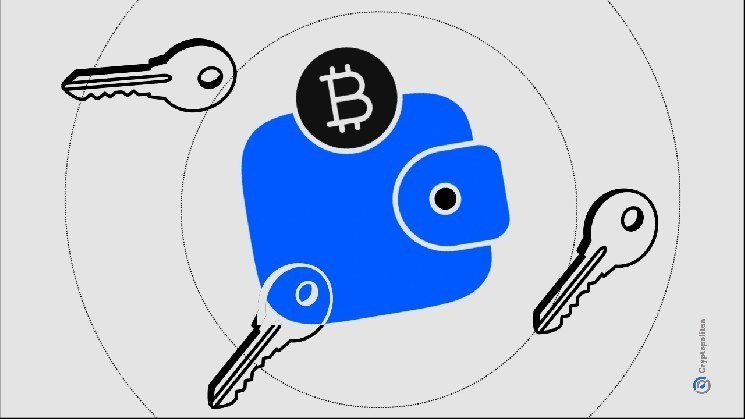The Rise of Multisig Wallets: Enhanced Security for Crypto Assets in 2025
Multisig Technology Takes Center Stage in Cryptocurrency Security Landscape
In today’s digital asset ecosystem, a silent revolution in security protocols has been unfolding. Over 60% of cryptocurrency custodians now employ multisignature (multisig) wallets to safeguard their assets. Major exchanges including Bybit and Binance have adopted this technology, and trending decentralized exchange Aster recently minted 8 billion ASTER tokens to a multisig wallet.
This widespread adoption signals a significant shift in how institutions and individuals approach cryptocurrency security. Multisig wallets have emerged as the preferred solution for balancing robust security with collaborative asset management, offering advantages that single-signature wallets like MetaMask and Phantom simply cannot match.
“The rise of multisignature technology represents a maturation in how we think about digital asset security,” explains blockchain security expert Maria Chen. “By eliminating single points of failure, these systems dramatically reduce vulnerability to both external attacks and internal mismanagement.”
However, multisig implementation is not without risks. Earlier this year, Bybit suffered a devastating $1.5 billion hack, while UXLINK recently lost $11.3 million—both incidents stemming from compromised multisignature wallets. These cases highlight that even advanced security measures require proper implementation and ongoing vigilance.
This comprehensive examination explores multisig technology’s foundations, operational mechanics, advantages, limitations, and future trajectory in cryptocurrency security.
Understanding Multisignature Wallet Technology: Fundamentals and Distinctions
The Multisig Security Framework
Multisig, short for multiple signatures, describes cryptocurrency wallets requiring two or more digital signatures to authorize a transaction. While implementation details vary across Bitcoin, Ethereum, and Solana networks, the fundamental principle remains consistent: transactions require consensus from multiple keyholders before execution.
When initiating a cryptocurrency transaction on-chain, a digital signature mathematically combines your private key with the transaction’s hash to prove ownership. Multisignature wallets extend this concept by necessitating multiple signers, each with unique private keys, to approve transactions collectively.
“Multisignature technology fundamentally transforms the authorization model,” notes Dr. Jonathan Myers, cryptography researcher. “It distributes authority across multiple stakeholders, creating a consensus-based approval system that mirrors how critical decisions are made in traditional financial institutions.”
These wallets can be configured with various threshold requirements—either mandating all keyholders’ authorization or establishing a minimum number of required signatures—offering flexibility for different security scenarios.
Comparison With Traditional Wallets
Standard cryptocurrency wallets—including Trust Wallet, Phantom, MetaMask, and even hardware options like Ledger—function as single-signature systems. One private key provides complete transaction authority, making these wallets straightforward for personal use, daily transactions, and dApp interactions.
Multisignature wallets, conversely, distribute control across multiple stakeholders. No individual can unilaterally authorize transactions, eliminating the single point of failure inherent in standard wallets. This distributed authority model explains why multisig has become the preferred choice for cryptocurrency firms and institutions managing substantial digital treasuries.
Individual investors with significant holdings also increasingly adopt multisig solutions, accepting the additional friction of requiring trusted third-party signatures as a worthwhile security tradeoff.
Banking System Parallels
Cryptographic signatures conceptually parallel traditional banking authorization methods. Your handwritten signature on a check serves essentially the same purpose as a digital signature: authorizing a specific transaction. Bank tellers verify this signature against reference files before permanently recording the transaction in their ledger system.
Traditional financial institutions have long employed their own multisignature equivalents. Joint accounts and corporate banking relationships often require multiple authorized signatories before processing high-value transactions—distributing responsibility and reducing fraud risk through consensus requirements.
The Mechanics of Multisignature Wallets: Technical Infrastructure
Multisignature wallets operate through considerably more complex mechanisms than standard cryptocurrency wallets, requiring careful technical implementation across three critical components: cryptographic key generation, threshold configuration, and transaction authorization protocols.
Key Generation Process
During multisig wallet setup, each participant independently generates a standard private key, which the wallet software uses to derive their corresponding public key. These public keys—never the private keys—are then shared among all participants.
Using specialized scripts or smart contracts (depending on the blockchain), these public keys are combined according to predetermined rules to create the multisignature receiving address. This address becomes the destination for funds, requiring the agreed-upon signature threshold for any outbound transactions.
Security researcher Elena Voskresenskaya emphasizes: “The beauty of multisig architecture lies in its cryptographic separation. Private keys never need to be shared or combined, preserving security while enabling collaborative control.”
The M-of-N Authorization Model
The foundation of multisig functionality is the M-of-N signature model, where N represents the total number of authorized keys, and M indicates the minimum signatures required for transaction validation. Common configurations include:
-
1-of-2 Wallets: Two authorized keys exist, but only one signature is required. This arrangement provides backup access while maintaining transaction simplicity.
-
2-of-3 Wallets: Three authorized keys exist, with two signatures required. This popular configuration balances security with resilience, as funds remain accessible even if one key is compromised or lost.
-
3-of-5 Wallets: Five authorized keys exist, requiring three signatures. This high-security arrangement accommodates larger organizations while providing redundancy against key loss.
-
N-of-N Wallets: All authorized keys must sign (e.g., “2-of-2”). While maximizing security, this approach creates significant operational risk if any keyholder becomes unavailable.
Transaction Workflow
The multisig transaction process orchestrates authorization across distributed keyholders. Using a 3-of-5 wallet as an example:
- One keyholder initiates a transaction (e.g., sending 1 BTC to a specified address)
- The transaction remains in pending status and is distributed to other keyholders
- Two additional keyholders must review transaction details and apply their signatures
- Once three total signatures are collected, the transaction achieves authorized status
- The fully signed transaction is broadcast to the blockchain network for processing
This deliberate, multi-party validation process introduces intentional friction that significantly enhances security against both external and internal threats.
Advantages of Multisignature Security: Beyond Basic Protection
Multisignature wallets offer compelling security benefits that explain their growing adoption among security-conscious investors and cryptocurrency organizations. These advantages extend beyond simple theft prevention to address fundamental vulnerabilities in digital asset management.
Robust Protection Against Sophisticated Attacks
By requiring multiple signatures, multisig wallets create a distributed security architecture resistant to common attack vectors. Even if sophisticated hackers compromise one private key, they cannot unilaterally withdraw funds—the wallet remains secure until the signature threshold is reached.
“Multisig fundamentally changes the attack economics,” explains cybersecurity analyst Marcus Williams. “Attackers must compromise multiple secure systems simultaneously, exponentially increasing difficulty while reducing the likelihood of successful theft.”
Additionally, most multisig implementations allow removal of compromised keys, enabling security recovery without asset transfer—a significant advantage over single-key wallets where compromise necessitates immediate fund migration.
Resilience Against Key Loss
Perhaps the most practical multisig advantage is protection against accidental key loss. With threshold signature schemes like 2-of-3 or 3-of-5, funds remain accessible even if individual keys are lost or damaged.
This resilience contrasts sharply with single-signature wallets, where private key loss typically results in permanent asset lockout. For high-value holdings, this redundancy provides critical protection against both technical failures and human error.
Collaborative Control for Organizations
Multisignature architecture elegantly solves the organizational control problem by distributing authority across multiple stakeholders. This shared custody model prevents unilateral actions by any single team member, ensuring that significant transactions receive appropriate review and approval.
“The multisig model aligns technical capabilities with organizational governance,” notes financial technology consultant Dr. Rebecca Torres. “It creates technological enforcement of checks and balances that previously relied solely on trust and policy.”
Transparency and Governance for Decentralized Organizations
Decentralized Autonomous Organizations (DAOs) particularly benefit from multisignature treasury management. By requiring consensus from multiple designated representatives before authorizing expenditures, DAOs establish transparent, trustless financial operations.
This approach ensures that community funds remain secure even if individual signatories become unavailable or act maliciously. The public nature of blockchain transactions combined with multisig requirements creates accountability without centralized authority.
Limitations and Challenges: The Multisig Trade-offs
Despite their significant security advantages, multisignature wallets present several important limitations and challenges that organizations must carefully consider before implementation.
Implementation Complexity
Setting up and using multisignature wallets demands significantly greater technical expertise than standard cryptocurrency wallets. The process involves complex cryptographic concepts, specialized software, and careful coordination between multiple participants.
This complexity creates barriers to adoption, particularly for individuals and smaller organizations without dedicated technical expertise. It also increases the risk of implementation errors that could compromise security or result in fund loss.
Operational Friction and Delays
The requirement for multiple signatures introduces unavoidable transaction delays. While standard wallets allow immediate transactions with a single approval, multisig transactions remain pending until the required number of signatures is collected.
“The security-convenience tradeoff is very real with multisig,” says blockchain advisor Janet Kim. “Organizations must carefully balance protection requirements against operational agility when selecting their threshold configuration.”
For time-sensitive operations or frequent transactions, these delays can create significant operational friction—a key reason many organizations maintain both multisig treasuries and smaller single-signature operational wallets.
Smart Contract and Implementation Vulnerabilities
The underlying code powering multisignature wallets introduces potential vulnerabilities beyond those affecting standard wallets. Smart contract bugs, interface flaws, or implementation errors can create unexpected security weaknesses.
The February Bybit hack vividly demonstrated this risk when attackers manipulated the transaction interface to alter the wallet’s smart contract logic, resulting in a catastrophic $1.5 billion theft. This incident highlights that multisig security ultimately depends on implementation quality.
Cross-Chain Limitations
Most multisignature solutions are blockchain-specific, creating challenges for organizations operating across multiple networks. A team using a Bitcoin multisig wallet typically needs separate solutions for managing Ethereum and Solana assets.
This fragmentation increases complexity, requires additional key management, and potentially creates security inconsistencies across an organization’s digital asset holdings.
Real-World Applications: Multisig in Action
Multisignature wallets have found practical application across numerous cryptocurrency use cases where security, shared control, or transaction verification are paramount concerns.
Corporate Treasury Management
Businesses and institutions managing significant cryptocurrency holdings increasingly employ multisig configurations like 2-of-3 or 3-of-5 to enforce internal controls. These arrangements ensure that major financial movements require consensus among key executives, mirroring traditional corporate treasury safeguards.
“Multisignature implementation has become standard practice for responsible corporate treasury management,” notes financial director Thomas Chen. “It provides the governance framework that institutional investors and boards of directors expect when handling digital assets.”
DAO Financial Operations
Decentralized Autonomous Organizations rely heavily on multisignature wallets to establish trustless treasury management. By distributing signature authority across elected community representatives, DAOs can operate transparently without centralizing control over community funds.
This approach maintains fund security even if individual signers become unavailable or compromised—a critical consideration for organizations with globally distributed, pseudonymous membership.
Joint Asset Management
Multisignature wallets enable secure joint cryptocurrency holdings between partners, family members, or business associates. A 2-of-2 configuration ensures that both parties must approve any transaction, preventing unilateral fund movements.
This capability provides a blockchain-native solution for shared financial resources without requiring trust in third-party custodians or complex legal agreements.
Cryptocurrency Escrow Services
The 2-of-3 multisig configuration has become standard for cryptocurrency escrow arrangements. This structure typically involves a buyer, seller, and neutral third-party arbitrator, with funds released only when two parties agree (either buyer and seller together, or the arbitrator siding with one party in case of dispute).
This trustless escrow mechanism enables secure peer-to-peer transactions without counterparty risk, facilitating everything from real estate purchases to cross-border business transactions using cryptocurrency.
Leading Multisignature Wallet Solutions in 2025
The multisignature wallet ecosystem continues to evolve, with several established solutions dominating the market in 2025. These platforms offer varying features, blockchain compatibility, and security models.
Safe (Formerly Gnosis Safe)
Safe remains the leading multisignature solution for the Ethereum ecosystem and EVM-compatible networks. Its smart contract-based architecture provides flexible threshold configurations, comprehensive transaction management, and extensive integration with the broader decentralized finance ecosystem.
The platform has become the de facto standard for DAO treasury management and institutional Ethereum holdings, securing billions in digital assets across thousands of organizations.
Casa
Casa offers a security-focused Bitcoin multisignature solution, often marketed as “vaults” rather than wallets. Co-founded by renowned Bitcoin security expert Jameson Lopp, Casa combines multisig technology with comprehensive key management protocols and limited stablecoin support.
The platform focuses on high-net-worth individuals and family offices seeking institutional-grade Bitcoin security with user-friendly implementation.
Electrum Multisig
Electrum Multisig provides a technically robust Bitcoin-focused multisignature solution favored by experienced cryptocurrency users. While its interface presents a steeper learning curve than newer alternatives, Electrum offers exceptional flexibility and compatibility with hardware security devices including Ledger and Trezor.
This solution particularly appeals to security-focused Bitcoiners who prioritize technical capability over user experience.
BitGo
BitGo delivers institutional-grade multisignature solutions across multiple blockchain networks. The platform supports both traditional multisignature and newer multi-party computation (MPC) approaches, providing flexible security options for different asset types and operational requirements.
With its comprehensive custody infrastructure and regulatory compliance features, BitGo primarily serves enterprise clients managing substantial cryptocurrency holdings.
Comparative Security Models: Multisig vs. Alternative Approaches
Understanding multisignature security requires comparing it with alternative cryptocurrency security approaches, each offering distinct advantages and limitations.
Multisig vs. Single-Signature Wallets
Standard cryptocurrency wallets—including popular options like MetaMask, Trust Wallet, and basic hardware wallets—rely on single-signature authorization. While these solutions offer simplicity and immediate transaction capability, they create a fundamental security vulnerability: compromise or loss of one private key results in complete asset loss.
Multisignature wallets distribute this risk across multiple keys and signatories, significantly improving resilience against both theft and accidental key loss. This security improvement comes at the cost of operational simplicity and transaction speed.
Multisig vs. Hardware Security
Hardware wallets like Ledger and Trezor primarily address private key extraction risk by storing keys in secure elements isolated from internet-connected devices. While providing excellent protection against remote attacks, these devices remain single-signature solutions vulnerable to physical theft, damage, or loss.
Many organizations combine approaches by requiring hardware wallet signatures within a multisig framework, leveraging the strengths of both security models.
Multisig vs. Multi-Party Computation (MPC)
Multi-Party Computation represents an emerging alternative to traditional multisignature approaches. Rather than requiring multiple distinct signatures, MPC cryptographically splits a single private key into encrypted shares distributed across multiple parties.
This approach achieves similar security distribution while maintaining single-signature compatibility with all blockchain protocols. However, MPC typically involves more complex cryptography and newer, less battle-tested implementations compared to traditional multisig.
The Future Trajectory of Multisignature Security
As cryptocurrency adoption accelerates, multisignature technology continues evolving to address emerging security challenges and operational requirements.
Deeper DeFi and DAO Integration
Multisignature wallets have become foundational infrastructure for decentralized finance and governance. This integration trend will likely accelerate with specialized multisig implementations designed specifically for DAO governance, automated liquidity management, and programmable treasury operations.
“We’re seeing multisig evolve from simple treasury protection to becoming the backbone of decentralized governance systems,” observes blockchain governance researcher Dr. Michael Zhao. “The technology is increasingly embedded in how decentralized organizations operate, not just how they secure assets.”
Hybrid Security Architectures
The cryptocurrency security landscape is moving toward hybrid approaches combining traditional multisignature models with newer technologies like multi-party computation. These solutions aim to preserve multisig’s security distribution while reducing operational friction and improving cross-chain compatibility.
Leading custody providers are already implementing these hybrid systems for institutional clients who require both robust security and operational efficiency for high-frequency transactions.
Expanding Institutional Adoption
As more traditional organizations establish digital asset treasuries, multisignature adoption will continue growing across different blockchain networks. Corporate treasury departments, investment funds, and traditional financial institutions increasingly recognize multisig as a minimum security standard for significant cryptocurrency holdings.
This institutional migration will likely drive further development of regulatory-compliant multisignature solutions incorporating additional governance, reporting, and compliance features beyond basic security.
The evolution of multisignature technology represents cryptocurrency’s broader maturation from experimental technology to institutional-grade financial infrastructure. Despite implementation challenges and occasional security incidents, the fundamental security model has proven remarkably effective at protecting digital assets in an increasingly complex threat environment.















